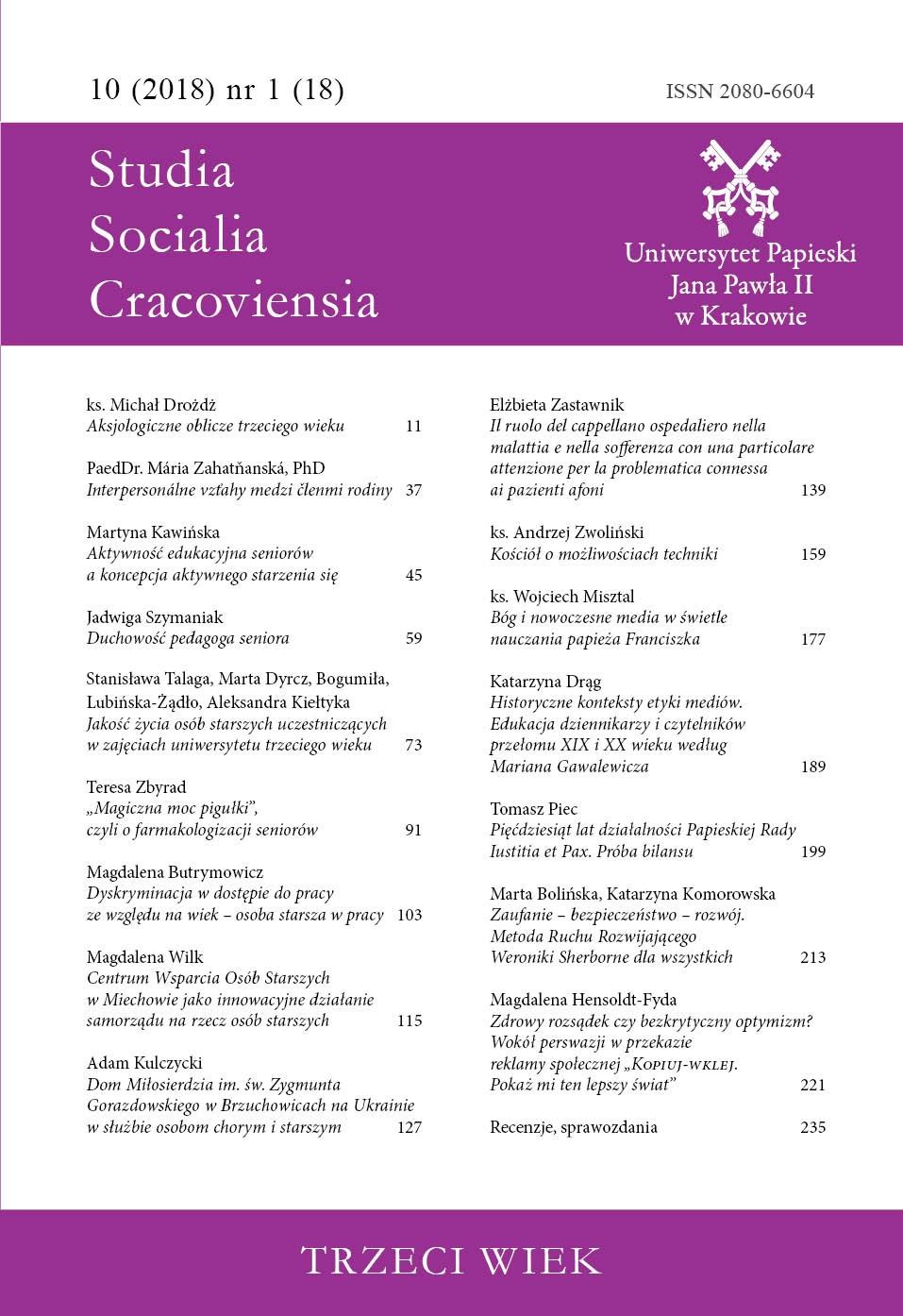Educational activity of seniors and the concept of active aging
DOI:
https://doi.org/10.15633/ssc.2595Keywords:
old age, seniors, educational activity of seniors, education, agingAbstract
Educational activity of seniors and the concept of active aging. The article is an attempt to answer the question of how to manage inevitable old age in a changing reality. The aim of the presented study is to present the concept of active aging and to define the role of education in this process. The presented considerations are of theoretical nature, deepened by the literature of the subject and statistical studies. The main conclusion from the study is the belief that education is not only an opportunity, but a guarantee of active aging, provided that it will be implemented in a systemic and long-lasting way.References
Duchowy rozwój człowieka, red. P. Socha, Kraków 2000.
Eurostat 2017, Adult learning statistics, Lifelong learning, 2011 and 2016, http://ec.europa.eu/eurostat/statistics-explained/index.php/File:Lifelong_learning,_2011_and_2016_(¹)_(%25_of_the_population_aged_25_to_64_participating_in_education_and_training)_YB17.png (15.12.2017).
Fabiś A., Edukacja seniorów – odpowiedź na wymagania współczesności, „Edukacja Dorosłych” (2006) nr 1–2, s. 33–44.
GUS 2013, Kształcenie dorosłych 2011, Warszawa 2013.
GUS 2014, Sytuacja demograficzna osób starszych i konsekwencje starzenia się ludności Polski w świetle prognozy na lata 2014–2050, Warszawa 2014.
Halicki J., Zaspokajanie potrzeb edukacyjnych jako czynnik aktywnego starzenia się, w: Aktywne starzenie się. Przeciwdziałanie barierom, red. P. Szukalski, B. Szatur-Jaworska, Łódź 2013, s. 142–151.
Halik J., Starzenie się społeczeństw jako proces demograficzny, w: Starzy ludzie w Polsce. Społeczne i zdrowotne skutki starzenia się społecznego, red. J. Halik, Warszawa 2002, s. 9–27.
Hill D. R., Pozytywne starzenie się. Młodzi duchem w jesieni życia, przeł. M. Lipa, Warszawa 2009.
Jurek Ł., Aktywne starzenie się jako paradygmat w polityce społecznej, „Polityka Społeczna” (2012) nr 3, s. 8–12.
Kamiński A., Funkcje pedagogiki społecznej, Warszawa1974.
Kargul J., Obszary pozaformalnej i nieformalnej edukacji dorosłych. Przesłanki do budowy teorii edukacji całożyciowej, Wrocław 2005.
Konieczna-Woźniak R., Uczenie się jako strategia pozytywnego starzenia się, „Rocznik Andragogiczny” 20 (2013), s. 185–200.
Kowalska-Dubas E., Lifelong learning – aktualizowanie wiedzy, umiejętności i kwalifikacji, w: Rozwiązania sprzyjające aktywnemu starzeniu się w wybranych krajach Unii Europejskiej. Raport końcowy, red. E. Kryńska, P. Szukalski, Łódź 2013, s. 59–72.
Ministerstwo Rodziny, Pracy i Polityki Społecznej, Informacja o sytuacji osób starszych w Polsce za rok 2015, Warszawa 2016.
Miś L., Ery i fazy rozwoju w życiu człowieka dorosłego w ujęciu Daniela J. Levinsona, w: Duchowy rozwój człowieka, red. P. Socha, Kraków 2000, s. 45–60.
Podstawy gerontologii społecznej, red. B. Szatur-Jaworska, P. Błędowski, M. Dzięgielewska, Warszawa 2006.
Richert-Kaźmierska A., Forkiewicz M., Kształcenie osób starszych w koncepcji aktywnego starzenia się, w: „Studia Ekonomiczne” 131 (2013), s. 127–139.
Roguska A., Edukacja permanentna osób dorosłych w starości, w: Edukacja permanentna dorosłych w dobie przemian, red. T. Zacharuk, B. Boczukowa, Kielce 2009, s. 76–82.
Sienkiewicz-Wilowska J. A., Społeczne aspekty bycia seniorem a rozwój osób w okresie późnej dorosłości, w: Edukacja osób starszych. Uwarunkowania – trendy – metody, Warszawa 2013, s. 27–40.
Szukalski P., Przygotowanie do starości jako zadanie dla jednostek i zbiorowości, w: Przygotowanie do starości. Polacy wobec starzenia się, red. P. Szukalski, Warszawa 2009, s. 39–55.
Szukalski P., Starzenie się ludności – wyzwanie XXI wieku, w: P. Szukalski, Z. Szweda-
-Lewandowska, Elementy gerontologii społecznej. Skrypt dla studentów Podyplomowego Studium Gerontologii Społecznej UŁ, Łódź 2014, s. 5–26.
Downloads
Published
Issue
Section
License
Authors who publish with this journal agree to the following terms:
- Authors retain the copyright and full publishing rights without restrictions, and grant the journal right of first publication with the work simultaneously licensed under a Creative Commons Attribution 4.0 International License that allows others to share the work with an acknowledgement of the work's authorship and initial publication in this journal.
- Authors are able to enter into separate, additional contractual arrangements for the non-exclusive distribution of the journal's published version of the work (e.g., post it to an institutional repository or publish it in a book), with an acknowledgement of its initial publication in this journal.
- Authors are permitted and encouraged to post their work online (e.g., in institutional repositories or on their website) prior to and during the submission process, as it can lead to productive exchanges, as well as earlier and greater citation of published work (See The Effect of Open Access).

